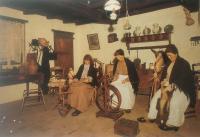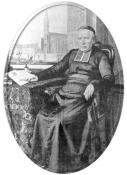 The story of the Holy Union Sisters began in northern France in the turbulent years after the French Revolution. Four women whose goodness, friendship, and skill brought them together in community and service well before they met Father Debrabant. Louise Mennecier, Lucie Contraine, Marie Garçon and Josephine Pollet, needleworkers by trade, lived together near the poorhouse in Douai, France, taught catechism to the local children and needlework skills to girls who resided in the poorhouse. When the recently ordained Abbe Jean Baptiste Debrabant arrived in the parish, he and the four needleworkers met; together they began to weave a tapestry that became the Congregation of the Holy Union. Of the original four women, only Lucie became a Holy Union Sister.
The story of the Holy Union Sisters began in northern France in the turbulent years after the French Revolution. Four women whose goodness, friendship, and skill brought them together in community and service well before they met Father Debrabant. Louise Mennecier, Lucie Contraine, Marie Garçon and Josephine Pollet, needleworkers by trade, lived together near the poorhouse in Douai, France, taught catechism to the local children and needlework skills to girls who resided in the poorhouse. When the recently ordained Abbe Jean Baptiste Debrabant arrived in the parish, he and the four needleworkers met; together they began to weave a tapestry that became the Congregation of the Holy Union. Of the original four women, only Lucie became a Holy Union Sister.
 Other young women joined the original group and as their numbers quickly grew, Fr. Debrabant set out to obtain the recognition of the Church for this group of pious young women. In 1842 the Archbishop of the Cambrai Diocese raised their status to a diocesan institute with the formal title: Holy Union Sisters. This enabled over one-hundred women in four different ceremonies to pronounce public vows as Holy Union Sisters in 1843.
Other young women joined the original group and as their numbers quickly grew, Fr. Debrabant set out to obtain the recognition of the Church for this group of pious young women. In 1842 the Archbishop of the Cambrai Diocese raised their status to a diocesan institute with the formal title: Holy Union Sisters. This enabled over one-hundred women in four different ceremonies to pronounce public vows as Holy Union Sisters in 1843.
Proximity to the Belgian border led Fr. Debrabant to establish communities and schools in Tournai and surrounding areas of Belgium. The sisters established boarding and day schools in rural and urban settings. By the end of the 19th century, Holy Union Sisters were meeting the spiritual and educational needs of youth in England, Ireland, Argentina, and the United States, regardless of social class.
The gift of internationality brings with it a broadening of vision
and a deeper sense of community with the world.
Holy Union's Growth in the 19th Century
1840s: Holy Union began in France and Belgium. The sisters moved beyond diocesan and national boundaries to reach out to the needs of the times.
1860s: The sisters established schools in England and Ireland. They were first welcomed by the Benedictine Fathers in Bath, England. Soon they accepted invitations to begin schools in London followed by Ireland, where the first school began in Banagher, County Offaly.
1880s – 1890’s: When Father Debrabant died in 1880 at the age of 79, the Holy Union Sisters were firmly established in Europe. By the end of the 1880’s there were foundations in Argentina and the United States. In response to a request made to the General Council, sisters were missioned to the West Indies in 1890.
The 20th Century
Africa 1931: Four Holy Union Sisters from Europe and the United States opened the first mission in Dschang, Cameroon, located in the section of the country under the French mandate. For several decades, sisters from Europe and the United States were missioned there. The first Cameroonian sisters joined the Congregation in the late 1970’s after the country gained its independence. Today there are over seventy sisters in the Region of Cameroon.
1970's and Beyond
Tanzania Sisters from the Anglo-Hibernian Province began an educational ministry in northern Tanzania in the 1970’s. This expanded to include social development when a sister from the U.S. Province arrived in 1979 to minister in the capital, Dar es Salaam. Today sisters from Ireland form community with young Tanzanian sisters.
Haiti In 1987 Sisters Jean Joseph Dekock from France and Helen Ryder from Ireland came to minister in the diocese of Gonaives. Over the course of several years, sisters came from France, Ireland and the United States and missions were established in the diocese of Port au Prince, Gonaives and Port aux Paix.
2019
In 2019 four Cameroonian sisters began a two-year intercultural experience. They were missioned by the Congregation to give of themselves in service to the people of Argentina and Haiti and to be enriched by all that they received from the people of these countries. Soon after they arrived in their respective countries, the Covid-19 Pandemic presented them with many challenges.
